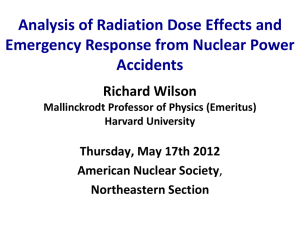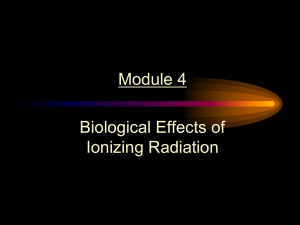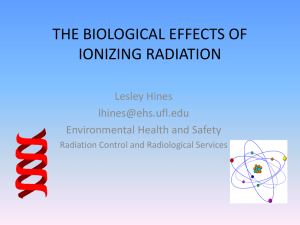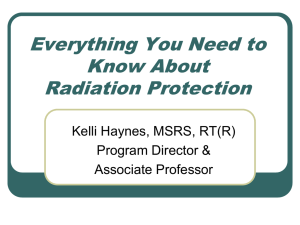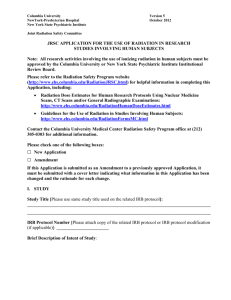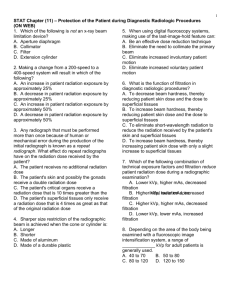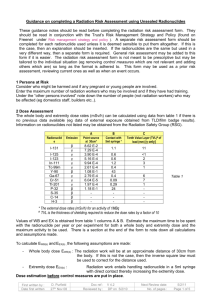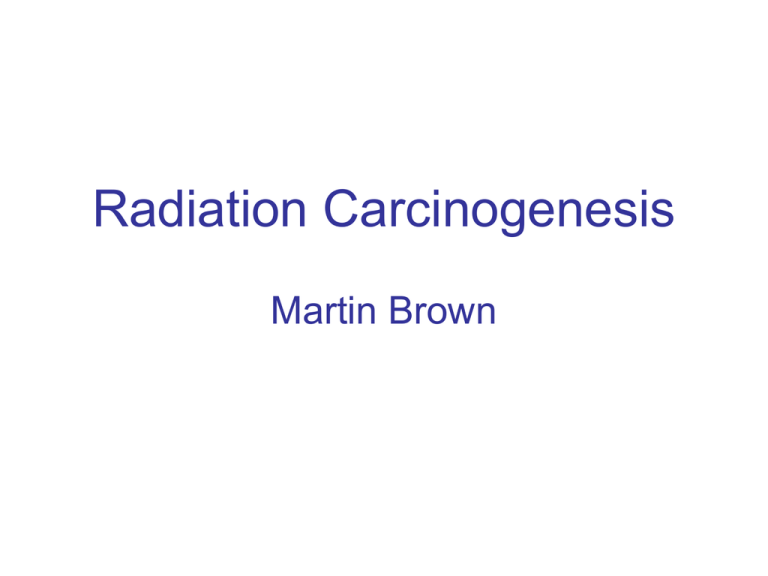
Radiation Carcinogenesis
Martin Brown
Two types of late effects of
irradiation
• Deterministic (non-stochastic) effects
– Severity increases with dose. There is a threshold.
Eg tissue fibrosis, cataracts.
– Mechanism involves effects (often cell kill) on
many cells.
• Stochastic Effects
– No threshold, probability increases with dose but
severity is independent of dose (eg cancer and
genetic effects)
It was known early after the discovery of
radiation that it could cause cancer
Both Marie Curie (the
discoverer of radium)
and her daughter Irene
died of leukemia probably due to their
radiation exposures
Mutations produce Cancer
• H J Muller (1927) found that X-rays induce
gene mutations in Drosophila (fruit flies)
and that they do so linearly with dose.
“The effect of X-rays, in occasionally producing cancer, may also be
associated with their action in producing mutations”.
• Bruce Ames. 1970’s: developed test in bacteria for
potency of chemicals to cause mutations - these
correlated with potency to cause cancer in rodents.
Simple idea: mutagens = carcinogens.
Radiation induced cancers
• Spectrum of cancers is same as that occurring
naturally.
• Severity of induced cancer is independent of
dose.
• Probability of cancer induction increases with
dose with no threshold.
• This is known as stochastic effect
• Mechanism is that cancer can arise from a
single mutation in a single cell.
Risk Estimates for Radiation Induced
Cancers
Information principally from…
• Occupationally Exposed: e.g., radium dial
painters, uranium miners, early x-ray users.
• Medically Exposed: e.g., ankylosing spondylitis,
tinea capitis, tuberculosis patients, children
irradiated for enlarged thymus
• Atomic Bomb Exposed: e.g., Hiroshima and
Nagasaki survivors.
Occupational exposure:
Bone cancer developed in the “radium dial painters”
Thyroid cancer development in individuals given Xirradiation for enlarged thymus in childhood
Hiroshima immediately after the bomb
Hiroshima chamber of Commerce- before 1945
The A-bomb dome today
Latent Periods
• For leukemias: Rise started 2 yrs after bomb
and reached peak 7-12 yrs after bomb. Most
cases observed by 15 yrs
• Solid Cancers: Excess risk started about 10
years after bomb, excess still continues 60
years after bomb. Thyroid cancer in children
has shorter latent period of ~5 yrs.
Breast cancer in A-bomb survivors
1958-1998
Preston et al, Rad Res.168 1-64,2007
Breast cancer in various irradiated
populations
A-bomb survivors
1950-1990
Relative vs
Absolute Risk
Dose response curve (relative risk) for all
cancers in A-bomb survivors 1958-1998
Data consistent with linear
dose response curve
Preston et al, Rad Res.168 1-64,2007
Compared to the number of people in H & N killed
outright (~100,000) the number of cancer deaths
attributable to the radiation dose is small
Preston et al, Rad Res.168 1-64,2007
Shape of dose response curve
A linear, non threshold model is
assumed for risk estimates and for
radiation protection
Dose Rate Effectiveness Factor (DREF) = Ratio of
cancer risk at high compared to low dose or low dose rate.
Best overall estimate of total
radiation induced cancer mortality
10% per Sv
(high doses/dose rates)
US Normal is ~ 16% for all cancers
Does this agree with 10% per Sv?
Cancer Risk after Radiotherapy 1
Increase in Relative Risk after Radiotherapy for Prostate Cancer
Second Cancers after Radiotherapy
for Cervix Cancer (Boice et al, 1985)
Boice et al: JNCI: 74.955, 1985
Cancer risk is relatively independent of dose for
high doses (Hall 2003)
Estimating cancer risk in any organ
after radiotherapy
•
Using a combination of the linear, non threshold estimates from the Abomb survivors and actual cancer risk from Hodgkin’s disease patients
treated at high doses (~ 40Gy), Schneider et al (Theoretical Biology and
Medical Modelling 2011, 8:27), constructed dose response data for all organs.
Below is the one for all cancers. They considered 3 different models:
Organ doses from Medical Radiation
Brenner & Hall, NEJM, 2007
Cancer incidence from CT scans
Of the 62 million CT scans, 4 million are on small children.
4 x 106 x 0.1% = 4 x 103 excess ca deaths per year
Brenner & Hall, NEJM, 2007
Summary
• Radiation is both a mutagen and a carcinogen
• Human risk estimates are based on a linear, non
threshold assumption for the dose response curve
• Human risks are based largely on the data from the
A-bomb survivors.
• Rule of thumb: 1 Sv (= 1Gy of X-rays) gives 10%
cancer death rate over spontaneous rate. Reduce by
factor of 2 for low doses and/or low dose rates.
• Radiation induces genomic instability by as yet
unknown mechanisms

